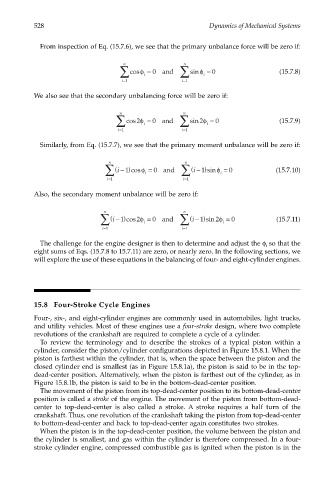Page 547 - Dynamics of Mechanical Systems
P. 547
0593_C15_fm Page 528 Tuesday, May 7, 2002 7:05 AM
528 Dynamics of Mechanical Systems
From inspection of Eq. (15.7.6), we see that the primary unbalance force will be zero if:
n
n
∑ cosφ = 0 and ∑ sinφ = 0 (15.7.8)
i
i
i=1 i=1
We also see that the secondary unbalancing force will be zero if:
n
n
∑ cos2φ = 0 and ∑ sin2φ = 0 (15.7.9)
i
i
i= 1 i= 1
Similarly, from Eq. (15.7.7), we see that the primary moment unbalance will be zero if:
n
n
∑ ( i − ) 1 cosφ i = 0 and ∑ ( i − ) 1 sinφ i = 0 (15.7.10)
i=1 i=1
Also, the secondary moment unbalance will be zero if:
n
n
∑ ( i − ) 1 cos 2φ i = 0 and ∑ ( i − ) 1 sin 2φ i = 0 (15.7.11)
i=1 i=1
The challenge for the engine designer is then to determine and adjust the φ so that the
i
eight sums of Eqs. (15.7.8 to 15.7.11) are zero, or nearly zero. In the following sections, we
will explore the use of these equations in the balancing of four- and eight-cylinder engines.
15.8 Four-Stroke Cycle Engines
Four-, six-, and eight-cylinder engines are commonly used in automobiles, light trucks,
and utility vehicles. Most of these engines use a four-stroke design, where two complete
revolutions of the crankshaft are required to complete a cycle of a cylinder.
To review the terminology and to describe the strokes of a typical piston within a
cylinder, consider the piston/cylinder configurations depicted in Figure 15.8.1. When the
piston is farthest within the cylinder, that is, when the space between the piston and the
closed cylinder end is smallest (as in Figure 15.8.1a), the piston is said to be in the top-
dead-center position. Alternatively, when the piston is farthest out of the cylinder, as in
Figure 15.8.1b, the piston is said to be in the bottom-dead-center position.
The movement of the piston from its top-dead-center position to its bottom-dead-center
position is called a stroke of the engine. The movement of the piston from bottom-dead-
center to top-dead-center is also called a stroke. A stroke requires a half turn of the
crankshaft. Thus, one revolution of the crankshaft taking the piston from top-dead-center
to bottom-dead-center and back to top-dead-center again constitutes two strokes.
When the piston is in the top-dead-center position, the volume between the piston and
the cylinder is smallest, and gas within the cylinder is therefore compressed. In a four-
stroke cylinder engine, compressed combustible gas is ignited when the piston is in the

